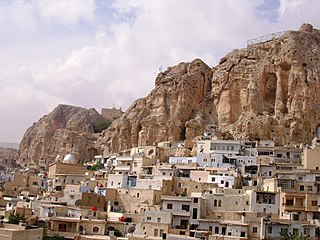
Maaloula is a town in the Rif Dimashq Governorate in Syria. The town is located 56 km to the northeast of Damascus and is built into the rugged mountainside at an altitude of more than 1,500m. It is known as one of two remaining villages where Western Neo-Aramaic is spoken, the other one being the nearby smaller village of Jubb'adin. Until the Syrian Civil War, Bakhʽa also had speakers of Western Neo-Aramaic. However, Bakhʽa was completely destroyed during the war, and all the survivors fled to other parts of Syria or to Lebanon.
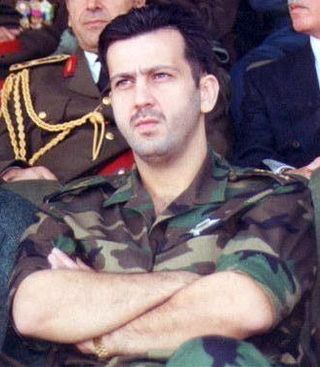
Maher al-Assad is a Syrian general and commander of the Syrian Army's elite 4th Armoured Division, which together with Syria's Military Intelligence form the core of the country's security forces. He is also a member of the Central Committee of the Ba'ath Party's Syrian Regional Branch.
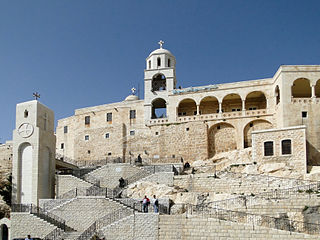
Christians in Syria made up about 10% of the pre-war Syrian population. The country's largest Christian denomination is the Greek Orthodox Church of Antioch, closely followed by the Maronite Church and the Assyrian Church of the East; the cities of Damascus and Aleppo are believed to have the largest number of Christians in Syria. There is a small minority of Protestants in the country.

Since the start of the Syrian Civil War, all sides have used social media to try to discredit their opponents by using negative terms such as 'Syrian regime' for the government, 'armed gangs/terrorists' for the rebels, 'Syrian government/US State Department propaganda', 'biased', 'US/Western/foreign involvement'. According to the Stockholm International Peace Research Institute, given the complexity of the Syrian conflict, media bias in reporting remains a key challenge, plaguing the collection of useful data and misinforming researchers and policymakers regarding the actual events taking place.
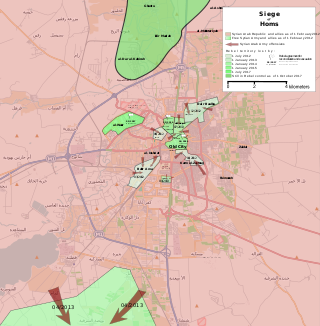
The siege of Homs was a military confrontation between the Syrian military and the Syrian opposition in the city of Homs, a major rebel stronghold during the Syrian Civil War. The siege lasted three years from May 2011 to May 2014, and ultimately resulted in an opposition withdrawal from the city.
The following is a timeline of the Syrian Civil War from January to April 2012, during which time the spate of protests that began in January 2011 lasted into another calendar year. An Arab League monitoring mission ended in failure as Syrian troops and anti-government militants continued to do battle across the country and the Syrian government prevented foreign observers from touring active battlefields, including besieged opposition strongholds. A United Nations-backed ceasefire brokered by special envoy Kofi Annan met a similar fate, with unarmed UN peacekeepers' movements tightly controlled by the government and fighting.
Gilles Jacquier was a French photojournalist and reporter for France Télévisions. Jacquier worked as a special correspondent for Envoyé spécial, one of France's best known documentary programs which airs on France 2. He had a successful career, has covered major international military conflicts and won many awards during his life. He was killed on 11 January 2012 while covering the ongoing Syrian Civil War in Homs, Syria. Jacquier was the first Western journalist killed in Syria since the beginning of the Syrian Civil War.

The Syrian Civil War is an intensely sectarian war. After the early years of cross-sectarian opposition to the rule of Bashar al-Assad, the civil war has largely transformed into a conflict between ruling minority Alawite government and allied Shi'a governments such as Iran; pitted against the country's Sunni Muslim majority who are aligned with the Syrian opposition and its Turkish and Persian Gulf state backers. Sunni Muslims make up the majority of the Syrian Arab Army (SAA) and many hold high administrative positions, while Alawites and members of almost every minority have also been active on the rebel side.

The Farouq Brigades, also spelt Farooq and Farook, was an armed Islamist rebel group formed by a number of Homs based members of the Free Syrian Army early in the Syrian Civil War. The group rapidly expanded in size and prominence in 2012, before suffering internal splits and battlefield reversals in 2013 that greatly reduced its influence. By 2014, the group was largely defunct, with member factions joining other rebel groups. The brigades were named Farouq after Omar bin al-Khattab, a Sahaba (companion) of the Islamic prophet Muhammad and the second Caliph.

The al-Qusayr offensive was an operation by the Syrian Government forces against Opposition forces at al-Qusayr in Homs province, during the Syrian Civil War. The operation was launched on 4 April 2013. The Syrian Army, the Lebanese militia Hezbollah and the National Defense Forces played key roles in the attack. Its aim was to capture all villages around the rebel-held town of al-Qusayr, thus tightening the siege of the city and ultimately launching an attack on al-Qusayr itself. The region was an important supply route for rebels fighting Syrian government forces in Homs.
The following is a timeline of the Syrian civil war from May to December 2013. Information about aggregated casualty counts is found at Casualties of the Syrian Civil War.

The Ghouta chemical attack, was a chemical attack carried out by the forces of Syrian President Bashar al-Assad, in the early hours of 21 August 2013 in Ghouta, Syria during the Syrian civil war. Two opposition-controlled areas in the suburbs around Damascus were struck by rockets containing the chemical agent sarin. Estimates of the death toll range from at least 281 people to 1,729. The attack was the deadliest use of chemical weapons since the Iran–Iraq War.
The Battle of Maaloula was a battle of the Syrian Civil War fought in September 2013, when rebel forces attacked the town of Maaloula, a Christian majority town in which the population speaks mainly Western Neo-Aramaic. The town is located 56 km to the northeast of Damascus, and built into the rugged mountainside, at an altitude of more than 1500 metres.

The Rif Dimashq offensive was a Syrian government forces and allies offensive in the Rif Dimashq Governorate that was launched in late March 2013, as part of the Syrian Civil War.

The Battle of Qalamoun started on 15 November 2013, with air strikes on the town of Qara, in the strategic Qalamoun region, in an attempt by the Syrian Army to cut rebel supply lines to Damascus from Lebanon. The strategic region had been used by rebel forces as a rear base for its operations around the capital Damascus. For its part, government forces had been using the nearby highway to link Damascus with the central Homs province and had multiple weapons depots in the area. The battle was primarily led on the rebel side by the Al-Nusra Front.
The 2014 Kafr Zita chemical attack occurred on 11 April 2014, in the rebel-held northern Syrian town of Kafr Zita during the Syrian Civil War. The attack reportedly wounded around 100 people and killed three. Syria's state television, SANA blamed the attack on the Islamist Al-Nusra Front using "toxic chlorine", while the opposition blamed barrel bombs dropped by government forces.
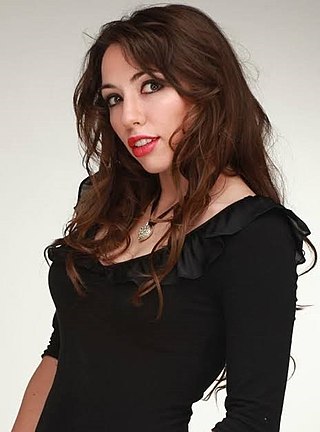
Maram Susli, also known as Mimi al-Laham, PartisanGirl, Syrian Girl and Syrian Sister, is a Syrian Australian conspiracy theorist, YouTube content creator, and political commentator who prepares videos on the Syrian Civil War, United States foreign policy in the Middle East, and the Gamergate controversy.

The Guardians of the Dawn were a coalition of Christian pro-government militias which are involved in the Syrian Civil War and affiliated with the Air Force Intelligence Directorate. Although the Guardians of the Dawn, whose official motto is "A homeland that we do not protect is one we do not deserve to live in", promote themselves as a Syrian nationalist force, their fighters are primarily motivated by a concept of holy war to defend the Christian areas of Syria from hostile rebels. The militiamen of Usud al-Cherubim, one of the coalition's constituent groups, even refer to themselves as "mujahideen of the cross".
The following is a timeline of the Syrian Civil War from May to August 2017. Information about aggregated casualty counts is found at Casualties of the Syrian Civil War.
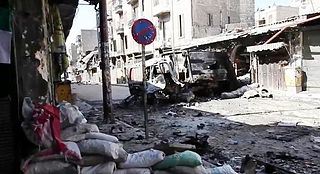
The 2012–2013 escalation of the Syrian Civil War refers to the third phase of the Syrian Civil War, which gradually escalated from a UN-mediated cease fire attempt during April–May 2012 and deteriorated into radical violence, escalating the conflict level to a full-fledged civil war.














